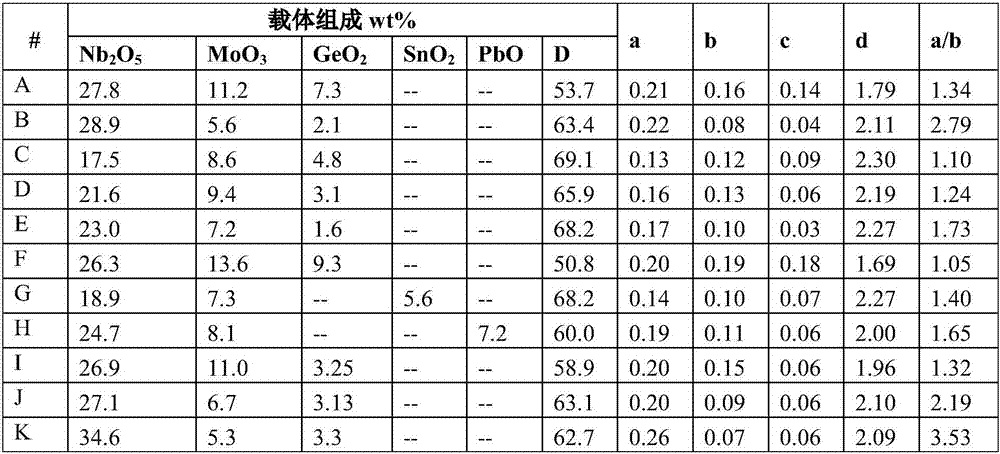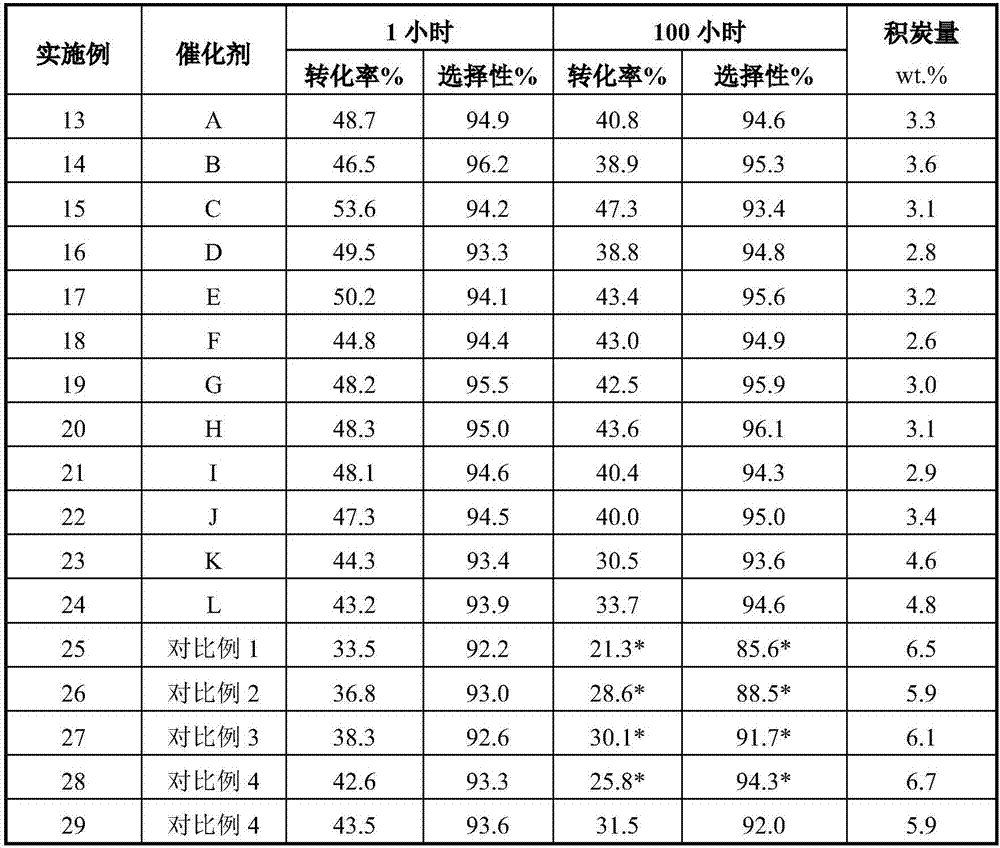Carrier of catalyst for preparing low-carbon alkene by dehydrogenation of low-carbon alkane and application of carrier
A catalyst carrier, low-carbon alkane technology, applied in the direction of catalyst carrier, hydrocarbons, hydrocarbons, etc., can solve the problems of large carbon deposition, rapid performance degradation and short single-pass life of the catalyst.
- Summary
- Abstract
- Description
- Claims
- Application Information
AI Technical Summary
Problems solved by technology
Method used
Image
Examples
Embodiment 1
[0026] Get 43.1g oxyfluoroniobic acid (H 2 (NbOF 5 )), 30.5g ammonium molybdate ((NH 4 ) 2 MoO 4 ) was dissolved in 1L of deionized water, and then 107.4g of silicon dioxide (80-120 microns in particle size) and 14.6g of germanium oxide (80-120 microns in particle size) were added to form a suspension; at 22°C, under vigorous stirring, the Slowly add 10% ammonia water dropwise into the mixed aqueous solution to form a precipitate, control the pH value to 7.8, stir for 2 hours, filter, wash with deionized water for 3 times, dry at 120°C, pulverize, and sieve at 700 ℃ for 16 hours to obtain a composite silica carrier. Pore volume 0.49cm 3 / g, specific surface area 87m 2 / g. The composition and properties of the carrier are shown in Table 1.
[0027] The obtained carrier adopts impregnation technology to load the platinum component, that is, at room temperature, 15.0 g of the obtained carrier is impregnated with chloroplatinic acid (H 2 PtCl 6 6H 2O, 0.12g) in aqueo...
Embodiment 2
[0030] Get 44.8g oxyfluoroniobic acid (H 2 (NbOF 5 )), 15.3g ammonium molybdate ((NH 4 ) 2 MoO 4 ) was dissolved in 1L deionized water, and then 126.8g of silicon dioxide (particle size 80-110 microns) and germanium oxide 4.2g (particle size 60-100 microns) were added to form a suspension; at 25°C, under vigorous stirring, the Slowly add 6% ammonia water dropwise into the mixed aqueous solution to form a precipitate, control the pH value to 8.0, stir for 2 hours, filter, wash with deionized water for 3 times, dry at 120°C, pulverize, and sieve at 720 ℃ for 12 hours to obtain a composite silica carrier. Pore volume 0.69cm 3 / g, specific surface area 104m 2 / g. The composition and properties of the carrier are shown in Table 1.
[0031] The obtained carrier adopts impregnation technology to load the platinum component, that is, at room temperature, 15.0 g of the obtained carrier is impregnated with chloroplatinic acid (H 2 PtCl 6 6H 2 O, 0.12g) in aqueous solution ...
Embodiment 3
[0034] Get 27.6g oxyfluoroniobic acid (H 2 (NbOF 5 )), 23.6g ammonium molybdate ((NH 4 ) 2 MoO 4 ) was dissolved in 1L of deionized water, and then 139.2g of silicon dioxide (30-80 microns in particle size) and 9.6g of germanium oxide (60-90 microns in particle size) were added to form a suspension; at 25°C, under vigorous stirring, the 15% ammonia water was slowly added dropwise to the mixed aqueous solution to form a precipitate, and the pH value was controlled to 8.0. After stirring for 2 hours, filter, wash with deionized water for 3 times, dry at 120°C, pulverize, and sieve the mixture at 820 ℃ for 8 hours to obtain a composite silica carrier. Pore volume 0.72cm 3 / g, specific surface area 116m 2 / g. The composition and properties of the carrier are shown in Table 1.
[0035] The obtained carrier adopts impregnation technology to load the platinum component, that is, at room temperature, 15.0 g of the obtained carrier is impregnated with chloroplatinic acid (H ...
PUM
| Property | Measurement | Unit |
|---|---|---|
| specific surface area | aaaaa | aaaaa |
| diameter | aaaaa | aaaaa |
| specific surface area | aaaaa | aaaaa |
Abstract
Description
Claims
Application Information
 Login to View More
Login to View More - R&D
- Intellectual Property
- Life Sciences
- Materials
- Tech Scout
- Unparalleled Data Quality
- Higher Quality Content
- 60% Fewer Hallucinations
Browse by: Latest US Patents, China's latest patents, Technical Efficacy Thesaurus, Application Domain, Technology Topic, Popular Technical Reports.
© 2025 PatSnap. All rights reserved.Legal|Privacy policy|Modern Slavery Act Transparency Statement|Sitemap|About US| Contact US: help@patsnap.com



